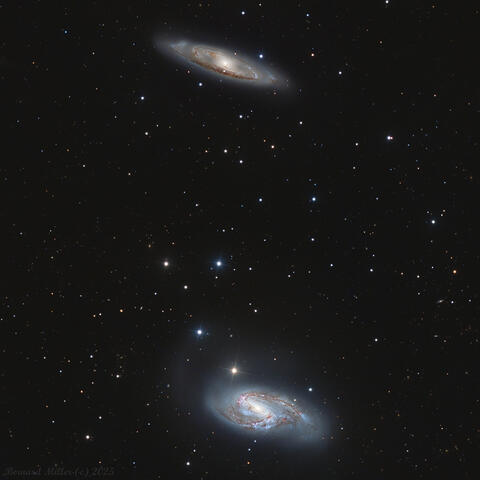[UPDATE #8] The road to launch - What’s next, and the Partners coming on board

Prefer to Listen Rather Than Read?
If you prefer to listen to this article instead of reading it, we’ve got you covered!
This blog post is now also available in audio format.
Stay updated on all the TL4 news, hands-free!
Hello, everyone!
Over the past few months, we’ve taken you behind the scenes of Telescope Live 4, unveiling the redesigned interface, new observation modalities, the retirement of Advanced Requests, and the results from our first phase of beta testing.
With most of the feedback implemented and minor bugs already resolved, we’re now entering the final stretch before launch.
Here’s what’s coming next
- In May, we’ll complete the platform migration from staging to live environment.
- Shortly after, we’ll open the Release Candidate phase - a near-final version of TL4 for a select group of users to help us run the final checks.
- The official public launch of TL4 is expected in Spring 2025.
But that’s not all.
Starting today, we’re excited to introduce you to the individuals and observatories that will play a key role in TL4’s future: our Telescope Live Partners Network.
These partners will contribute their telescopes and expertise to help us grow the platform’s data archive with a steady stream of high-quality astrophotography datasets.
Each week, we’ll spotlight a new partner and their setup, so you can get to know who’s behind the images and how their contributions will benefit your astrophotography experience.
Meet Bernard Miller

We’re kicking off this series with Bernard Miller, a seasoned astrophotographer whose work has been featured in Astronomy Magazine, the Sky & Telescope website, and even NASA’s APOD.
Bernard’s journey into astrophotography started in 2006 when he helped his son with a school project. A borrowed telescope and a few deep sky targets later, Bernard was hooked. From visual observing with a Celestron CPC-1100 to building his own remote observatory, his passion has only grown.
In 2017, Bernard upgraded to his current setup - a powerful, professional-grade configuration that will soon be contributing to TL4:
- Telescope: Planewave CDK-17
- Camera: FLI Proline PL16803
- Filters: Astrodon LRGB + 3nm Ha, OIII, SII
- Mount: Paramount ME
- Location: Dark Sky New Mexico, near Animas, USA
Bernard operates his observatory remotely and brings years of experience in both data acquisition and image processing. His images reflect a deep understanding of technique and an eye for the awe-inspiring details hidden in the cosmos.
Meet Mark Johnston

The other featured partner we want to introduce to you today is Mark Johnston - one of the leading solar imagers in the amateur astronomy world, and a true force of outreach and education.
Mark already contributes high-resolution solar datasets to Telescope Live, but with TL4, he will significantly expand his involvement by providing data from multiple solar telescopes, offering even greater variety and quality to our growing archive.
Based in Arizona, Mark benefits from clear, dry, and stable skies, ideal for high-resolution solar imaging. Over the years, he has built and refined a cutting-edge solar imaging setup capable of capturing the dynamic nature of the Sun in stunning detail.
Mark brings not only technical expertise but also a deep passion for astronomy education. He serves as a NASA Solar System Ambassador, an ACEAP ambassador to Chile, and is Vice President of the Phoenix Astronomical Society.
Through his imaging tutorials and public outreach, his work has reached millions of people around the globe.
His contributions to TL4 will come from a variety of advanced solar telescope systems, including:
- Telescope: Custom 160mm Ha double stack refractor
- Camera: Player One IMX174M and IMX678M
- Filters: Baader 160MM Ha ERF, Daystar Quark Chromosphere, Lunt 40mm etalon
- Mounts: ZWO AM5, Track The Stars TTS160
- Additional System: ML Astro SHG700 spectroheliograph for multi-wavelength full-disk solar imaging
Mark’s setups allow him to capture full-disk and close-up solar images in exquisite detail, with precision that rivals professional-level observatories.
How these Partners will contribute to the TL Archive
The TL4 Partner Network is not just about expanding telescope access - it’s about raising the standard of data available to our community.

With Bernard Miller, users will gain access to deep-sky datasets captured with a very powerful imaging setup: a 17” Planewave CDK, narrowband filters, and expert-level processing precision. His datasets will be especially valuable for those looking to tackle complex post-processing challenges, including faint nebulosity and deep structure.

With Mark Johnston, TL4 will offer something entirely new: high-resolution solar datasets captured with elite solar imaging equipment. From full-disk views to razor-sharp chromospheric detail, Mark’s contributions will open the door to solar astrophotography for TL4 users - an area that’s rarely accessible at this level of quality.
Together, these two partners bring diversity, depth, and expertise to the platform - ensuring that whether you’re exploring distant galaxies or the surface of our closest star, you’ll have access to data that inspires and elevates your astrophotography skills.
Next week, we’ll spotlight other members of the TL Partner Network and show you how the TL4 Network is growing - so stay tuned.
And as always, thank you for being part of this incredible community.
The future of astrophotography is almost here - and it’s brighter than ever!
Clear skies
